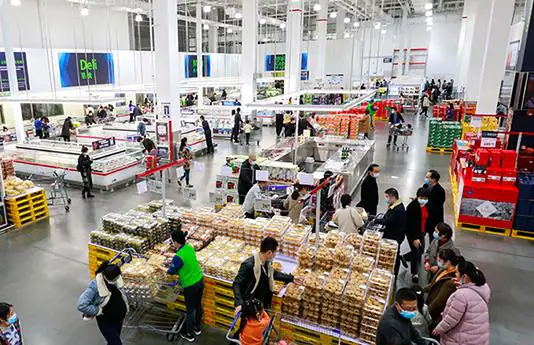Zhu Rui (Juliet), Professor of Marketing, Cheung Kong Graduate School of Business, Li Mengjun, Senior Manager at Social Innovation and Brand Research Center, Cheung Kong Graduate School of Business, hou Wei, Research Assistant at Social Innovation and Brand Research Center, Cheung Kong Graduate School of Business
China’s delivery industry has seen rapid growth rates in the last few years, exacerbated and propelled by its e-commerce economy. The total volume of express deliveries rose from 1.51 billion packages in 2008 to 63.52 billion packages in 2019, surpassing the United States, Japan, and advanced European economies combined. This accounts for more than 50% of global total deliveries, with e-commerce packages accounting for over 75%. In 2019, at the time of the Double Eleven (Single’s Day) shopping festival in China, the first 100 million packages were delivered in 2.4 days. Six years ago, it would have taken 9 days to deliver. This increase in speed reflects the Chinese express delivery enterprises’ common goal to “be faster and meet the deadline”. It is also a key factor that consumers consider when looking at safe and low-cost express delivery services.
However, the industry’s rapid growth and substantial improvement in delivery punctuality have led to high environmental and social costs. According to the Characteristics and Management of China’s Express Packaging Waste report (《中国快递包装废弃物产生特征与管理现状》), in 2018, China’s delivery industry consumed 8.3733 million tons of paper packaging materials (excluding the tracking label paper), and 851,800 tons of plastic packaging materials. Carbon emissions during the entire process from production to waste disposal of express packages surged from 611,500 tons in 2010, to 13.031 million tons in 2018, requiring 710 million trees to neutralize. Without effective environmental protection policies, the figure is estimated to reach 57.061 million tons by 2025. How express delivery enterprises adopt environmentally friendly practices, is a critical issue that needs thorough and immediate consideration.
Embracing Green Logistics and Its Related Problems in China
Aggressive market competition and increasingly prominent environmental and social issues have forced express delivery enterprises to explore ways to balance interests and responsibilities. The Report on the Green Development of the National Delivery Business (2018-2019) (《中国邮政快递绿色发展报告》) outlines the five main areas of green logistics: green packaging, green warehousing, green transport, green recycling, and green management. At present, green packaging and green recycling, such as the “Recyclable Delivery Box Plan”, are the most widely used means among China’s express delivery companies as they are relatively easier to implement. In terms of green warehousing and green management, large domestic logistics companies, such as JD Logistics and Suning Logistics, are leveraging big data in their unmanned warehouses and intelligent logistics. In 2017, JD Logistics implemented the world’s first full-process unmanned warehouse, leading to a 10-fold increase in efficiency. Similarly, Suning Logistics is expected to save RMB30 million annually by applying big data technology to optimize its transportation routes.
Despite these advancements, green logistics still faces numerous challenges in China, one being that green packaging is not popular. Although industry giants have adopted green packaging to some extent, its actual application rate is quite low compared to the overall business volume. Taking SF Express as an example, its business volume rose to 4.831 billion packages in 2019, but only 15 million of the packages used recyclable boxes, accounting for 0.3% of the total business volume. The recovery rate of packaging boxes is also low. The volume of packages from the express delivery business in 2019 reached 63.52 billion packages, yet the number of packages recycled by express delivery enterprises nationwide was only 200 million, accounting for only 0.3% of the total volume. The overall recovery rate of packaging waste in China overall is low at less than 20%. Especially when comparing this to the recovery rate of express packaging in Japan, which is as high as 95%, and the recovery rate of corrugated paper, the main packaging material in the United States, which can be as high as 93%.
One of the major reasons for the lack of adoption and advancement in green logistics is that the concept itself is not popular among consumers despite being emphasized by logistics enterprises in China. As a result, the efforts of green logistics in China are mostly reflected in logistics enterprises using recyclable express boxes.
Furthermore, there is a lack of environmental awareness among Chinese consumers and people involved in the delivery industry. Consumers focus more on faster deliveries and packaging quality when evaluating the service of express delivery companies, than on the environmental impact of faster deliveries and excessive packaging. Similarly, employees in the delivery industry have limited awareness of the environmental impact. Given that there are more than 3 million employees in China’s delivery industry, bolstering the environmental awareness of employees is critical for express delivery enterprises to promote environmental protection measures.
In order to advance green logistics in China, appropriate corporate codes of conduct and social policies and regulations need to be formulated. At present, most domestic express delivery enterprises have not defined clear carbon emission targets, nor have they formulated green logistic codes of conduct for their employees to practice. There is also no evaluation mechanism for green logistics in companies. Current domestic regulations on green logistics are little more than guidelines or advisory provisions. Most of these provisions are not legally enforceable and are too vague for enterprises to follow or for governments to supervise.
Enterprises need to be innovative in practicing green logistics
It is completely viable for large enterprises to apply green logistics to solve problems on a large scale in a profitable way. Companies such as delivery services and e-commerce platforms need to find ways to optimize their packaging and recycling so as to make the circular economy a reality. DHL, for example, has helped realize its own goals and its customers’ environmental protection objectives through its GoGreen project. Specific measures of this project include providing customers with carbon emission calculation reports, carbon neutral services, customized green logistics solutions, and other services that support customers’ green choices. By 2025, DHL hopes to increase revenues from green solutions to 50% of its total sales, making it the primary source of revenue, and creating a competitive edge as it goes green.
E-commerce platforms can also promote the development and application of green logistics through business model innovation. For example, in 2008 Amazon launched the Frustration-Free Packaging Program (FFP), which aims to encourage merchants to redesign and simplify packaging to be greener. To help businesses meet the requirements of the FFP program, Amazon has collaborated with large brands to redesign packaging, so that products can be transported in their original packaging without Amazon providing outer packaging boxes. This innovative business model reduces carbon emissions and transport costs for customers. Since the launch of FFP, Amazon has reduced its packaging materials by 665,000 tons, with 1.18 billion cartons having been replaced by recyclable or original packaging. In terms of packaging recycling, Loop, an American recycling shopping platform, has tried to solve the problem of express packaging recycling by collecting deposits and conducting door-to-door recycling programs. When consumers buy products with recyclable packaging on Loop, they pay a deposit ranging from 25 cents to 47 dollars depending on the item, and are able to procure products with recyclable packaging and express boxes. After receiving the package, the packaging is returned to the express box, which is then collected by UPS delivery at their doorstep.
We have mentioned above a few examples of innovative solutions from companies however we believe there is much more potential for improvement in this field. Most importantly, these enterprises are not only implementing green measures, but are also endeavoring to engage their consumers, suppliers, and customers to go green, using innovative methods. These are all worth emulating by Chinese enterprises.
The environmental awareness of the society needs to be improved
In 2007, the management team of Mars Inc., one of the top ten food companies globally, raised a far-sighted question— “What is the appropriate level of profitability?” The reason why this question was raised is that the pursuit of profit alone has led to several adverse environmental and social impacts. The fact that this question was raised 13 years ago is commendable. This question compels enterprises to pursue a path of mutual benefit. The following question is also worth considering in the delivery industry. “What kind of express service is optimal? How do we achieve both fast and cheap delivery that is sustainable?” As we know, sustainable development refers to development that meets the needs of the present without compromising the ability of future generations to meet theirs. Consequently, society needs to enhance its environmental awareness and keep the conversation going so that enterprises are motivated to consider energy conservation and emission reduction when formulating their strategies, and consumers are encouraged to be more aware of environmental protection. Only when consumers begin valuing environmental protection, can the whole society embrace green development.
In addition, the environmental awareness of employees in delivery companies also plays a vital role in developing green logistics. At present, over 3 million people are employed in China’s delivery industry. To advance the green delivery industry, it is vital that delivery companies help their employees foster an awareness on energy conservation and environmental protection through more training. Several well-known express delivery enterprises in other countries have begun improving the environmental awareness and related skills of their staff through internal training and professional certification. DHL, for instance, has 550,000 employees worldwide and believes that employees play a vital role in protecting the environment. DHL consistently emphasizes the concept of environmental protection among its employees, and trains and encourages them to adopt sustainable development practices. DHL plans to have 80% of its employees trained as GoGreen-certified experts by 2025, to ensure that they can actively participate in environmental and climate protection activities.
Industry associations should also play a larger role in improving environmental awareness. Industry associations are able to perfectly bridge government and enterprise. They are able to support the government in formulating standardized policies and promote green logistics, supervise and evaluate express enterprises in their performance and contributions to green logistics, create an ecosystem of green logistics among delivery enterprises, and promote green logistics in China through forums and exhibitions.
The government needs to improve laws and regulations to assist green logistics
China has not yet formulated thorough regulations or solutions for green logistics, whilst other major countries are making steady advancements.
The United States, for instance, has adopted tax reduction or exemption policies for recycling and packaging enterprises. To encourage enterprises to recycle old packaging, state governments in the United States are reducing or exempting taxes for companies that recycle packaging.
Germany has done so by implementing punitive measures. Germany’s new packaging law—German Packaging Act (VerpackG) came into effect on January 1st, 2019. The Act states that if a packaged product enters the German market and becomes a waste in the hands of consumers, the packaging manufacturers, distributors, and retailers are all responsible. The Act implements an extended producer responsibility system and brings important participants in the packaging life cycle into the prescribed framework. Germany has formulated a unique “dual system” of waste collection and has established a packaging waste recycling system based on its existing domestic waste recycling system. This has ensured that Germany’s comprehensive recycling rate of package waste has remained above 75% in recent years.
Similarly, Japan has performed quite well in green packaging. Japan has formulated and implemented the Containers and Packaging Recycling Law, and has also been developing a robust recycling system with numerous local recycling stations. The Japanese collection and transportation system regularly collects and transports packaging waste that has already been categorized by consumers to a special recycling station for recycling and re-manufacturing. This system enables Japan to maintain its recycling rate of express packaging at around 95%.
These examples highlight that government is indispensable in developing green logistics. Governments should regulate and supervise industry players such as logistics companies, upstream manufacturing enterprises and e-commerce platforms with incentives or punitive policies to make the delivery industry greener.




















